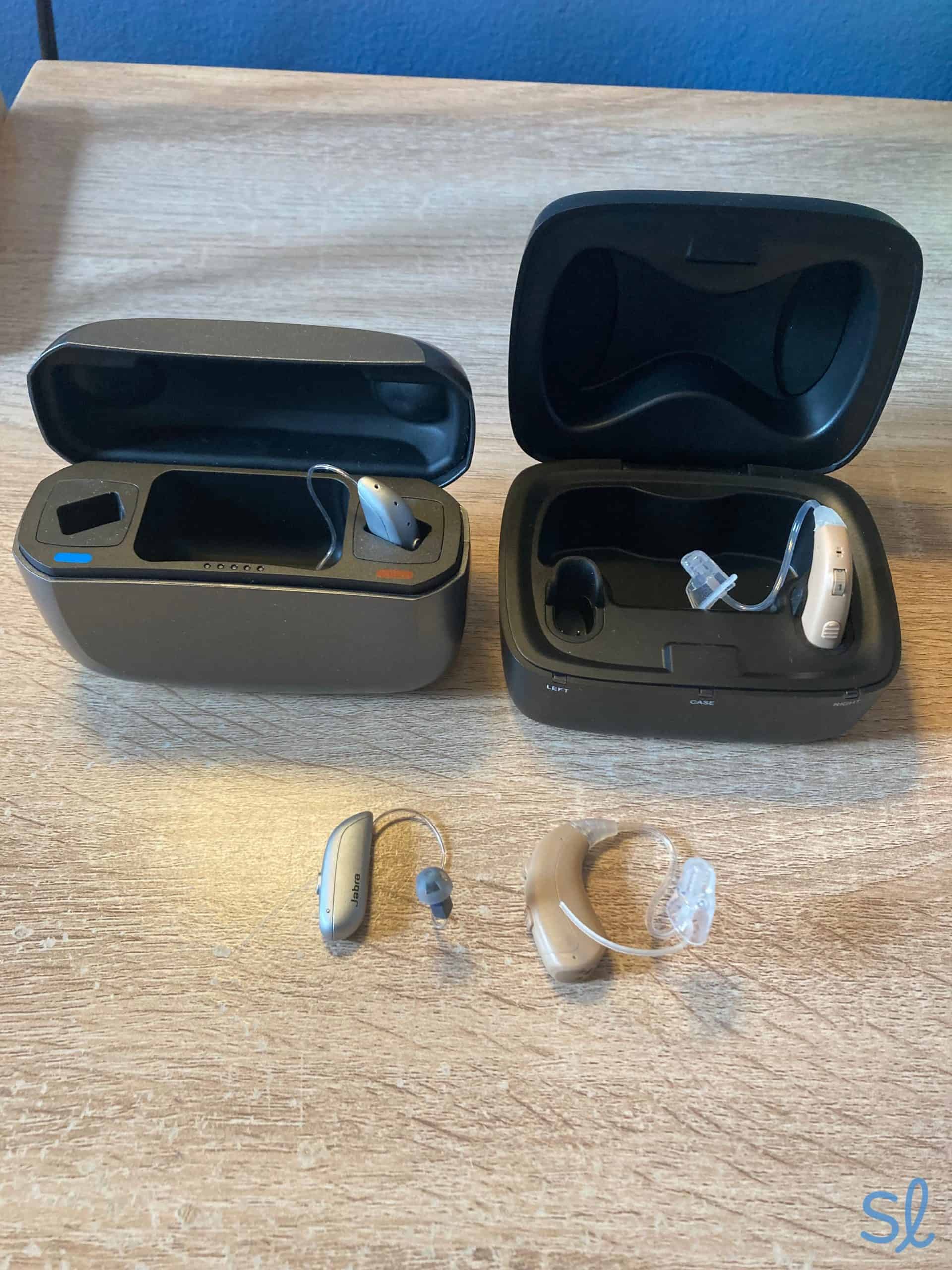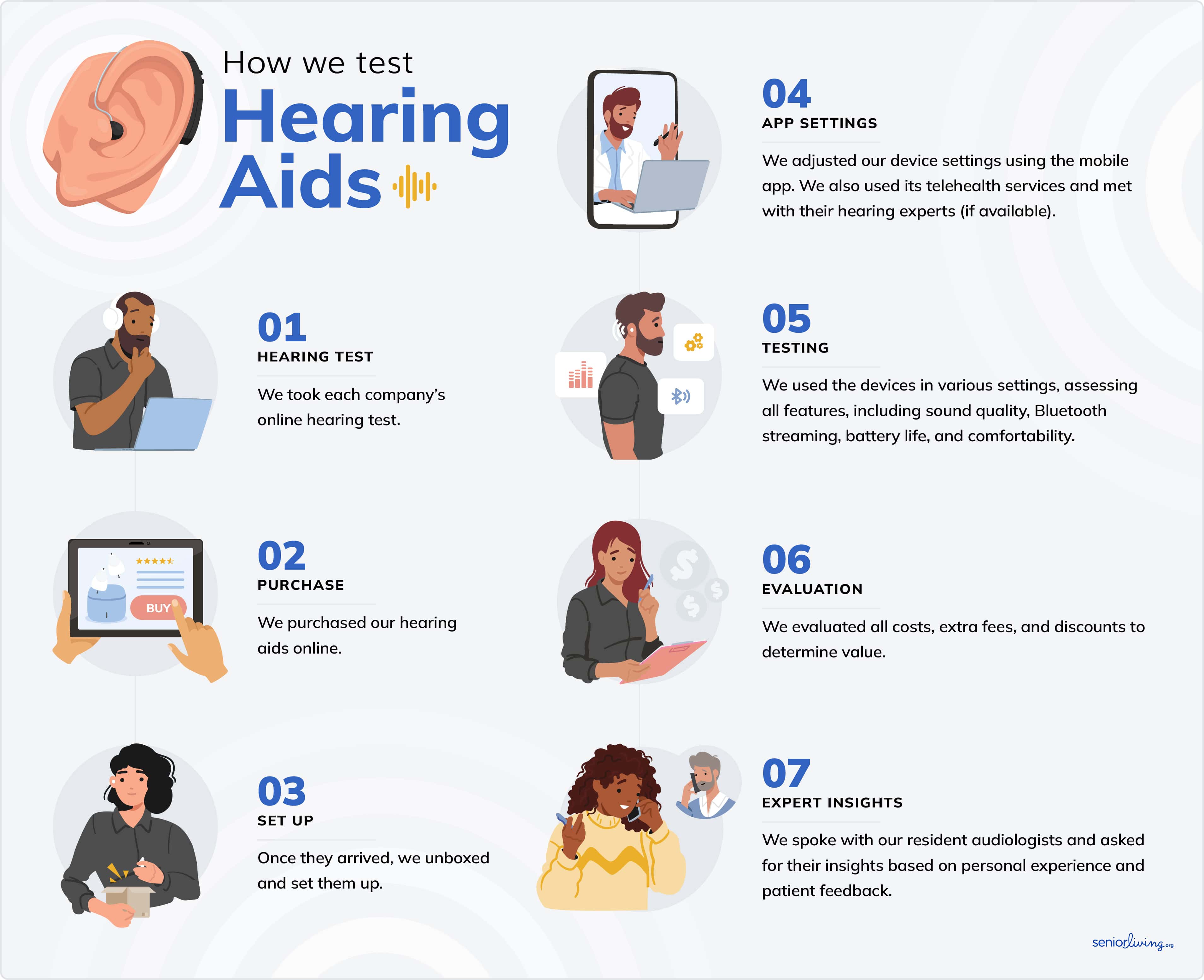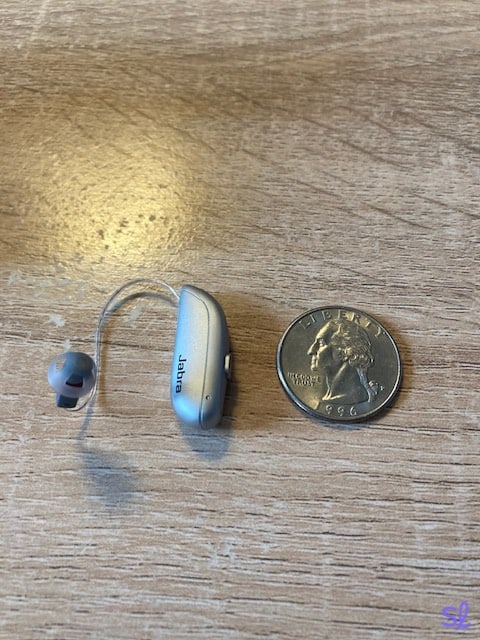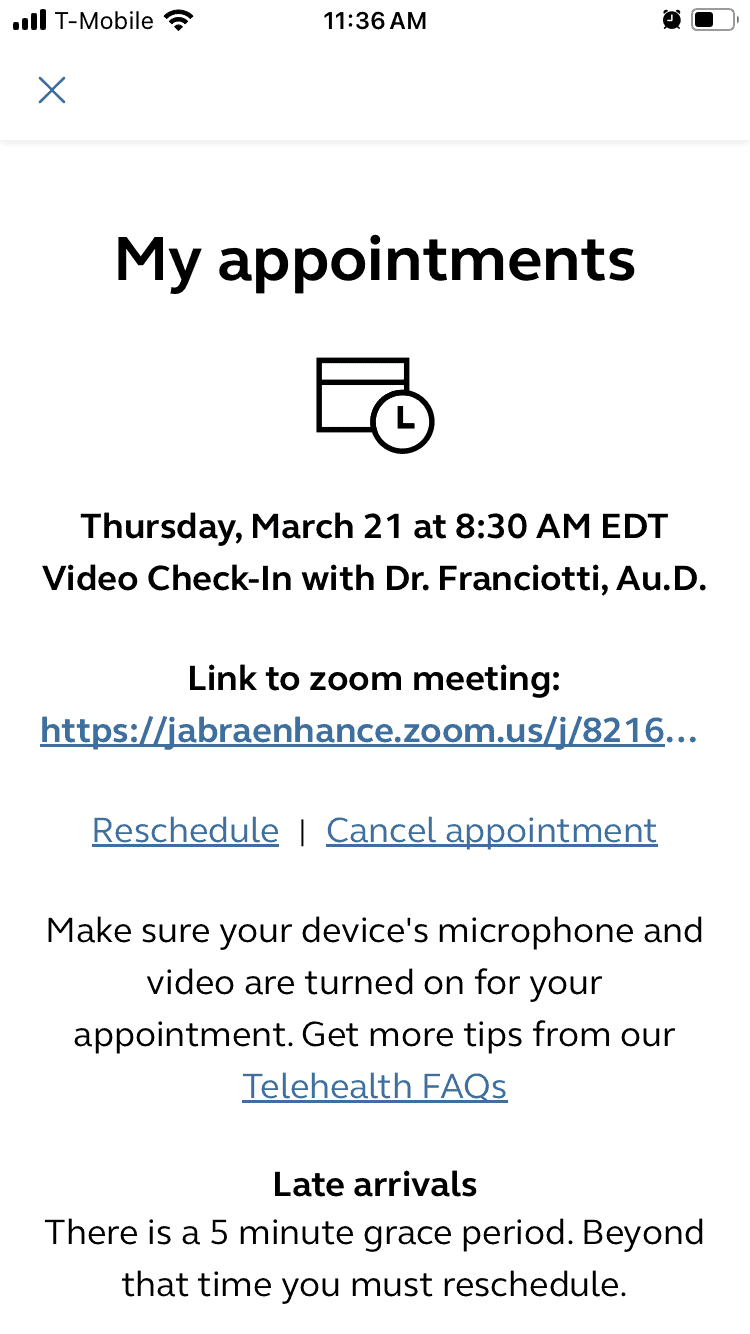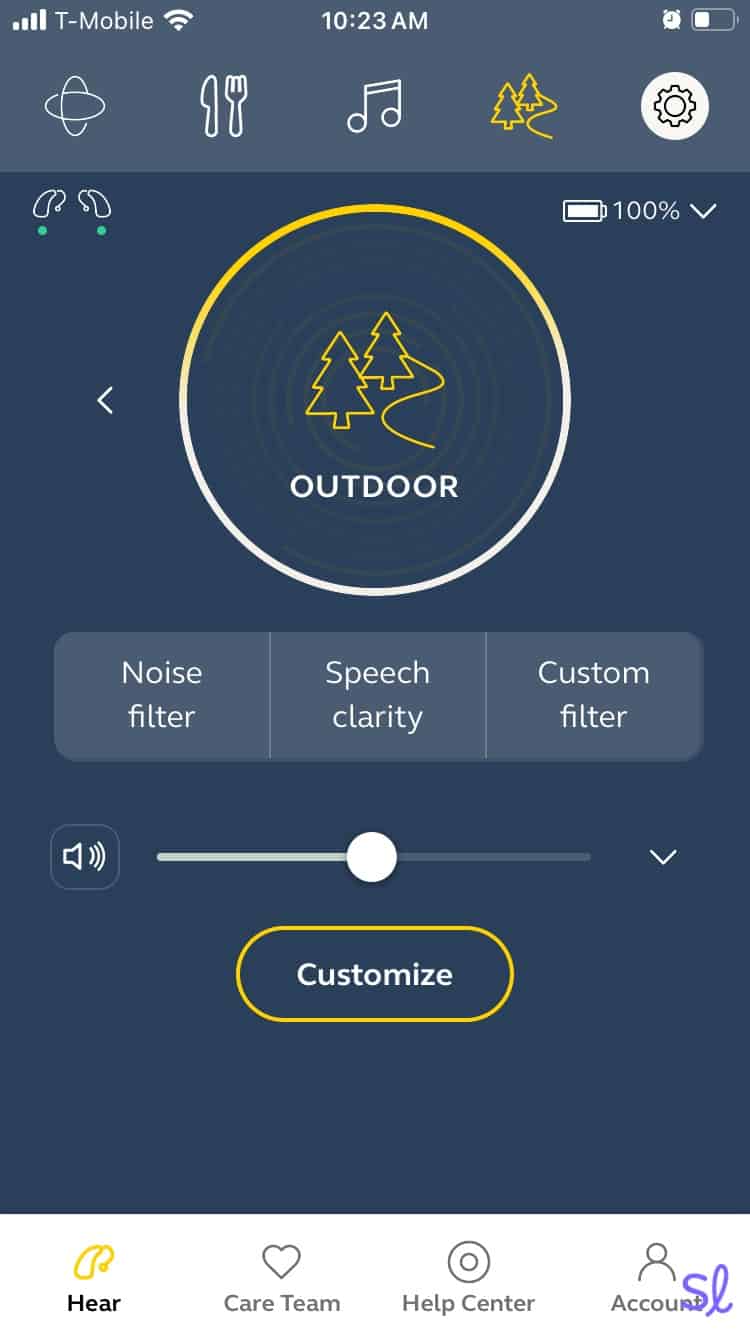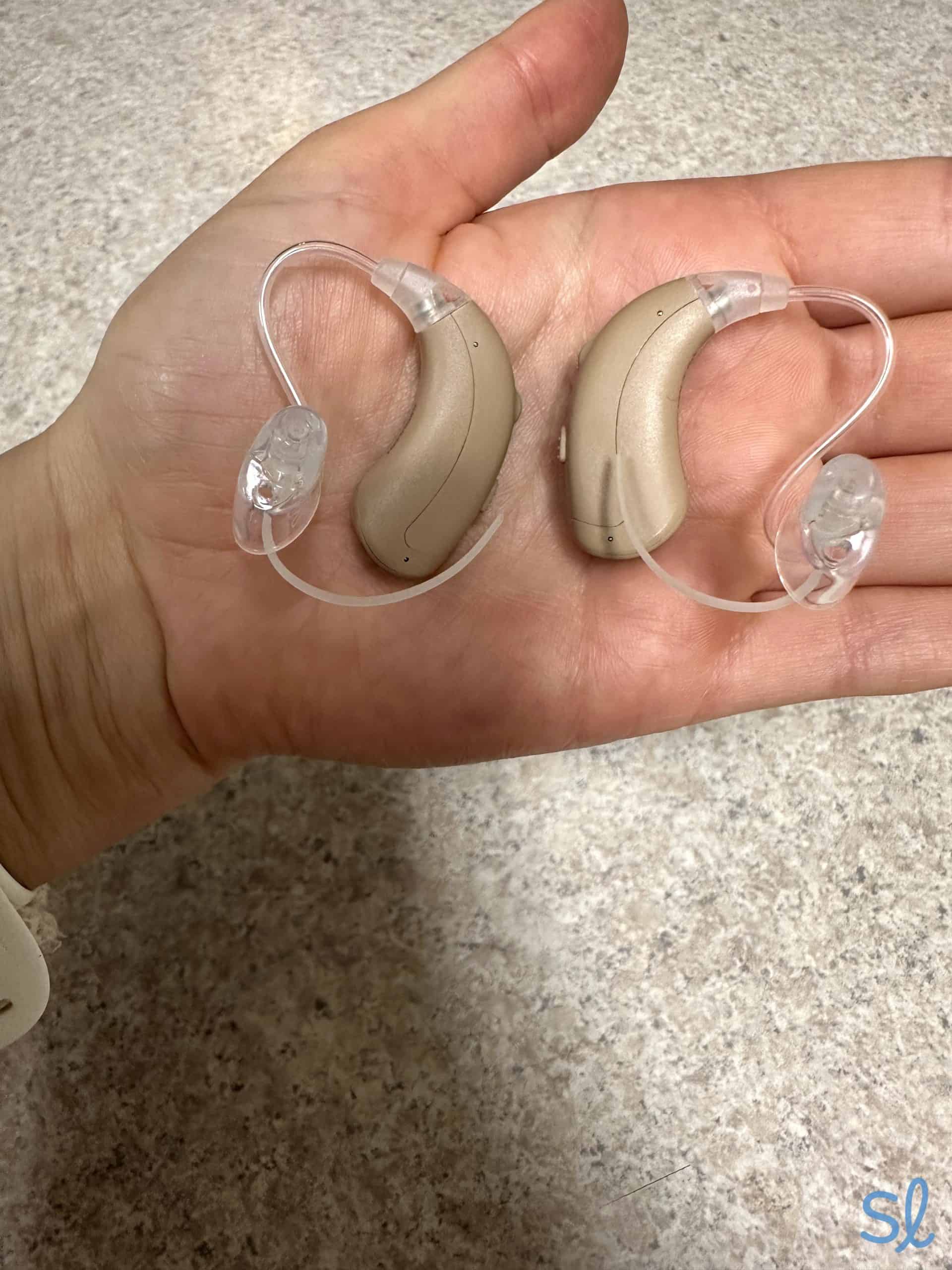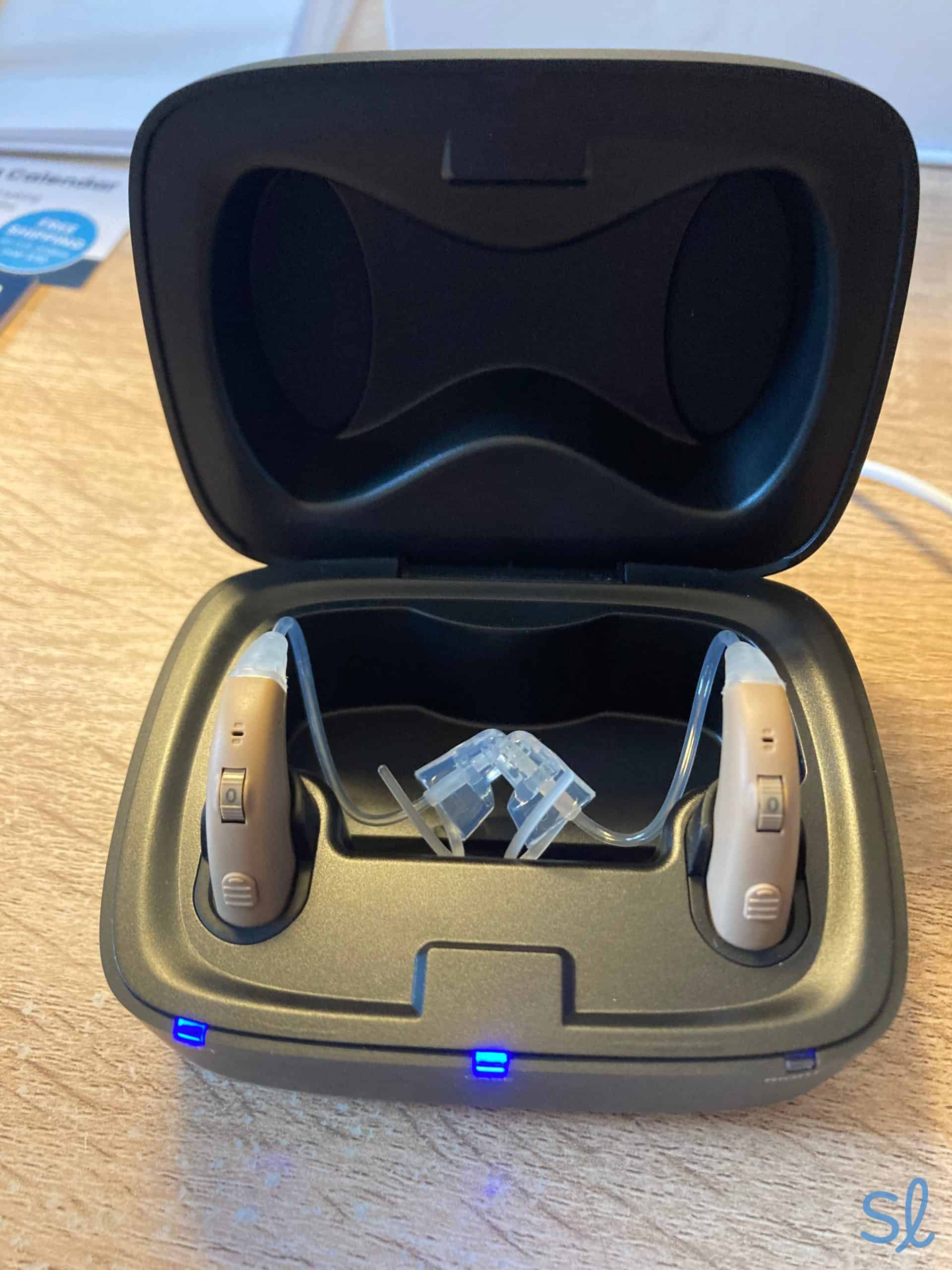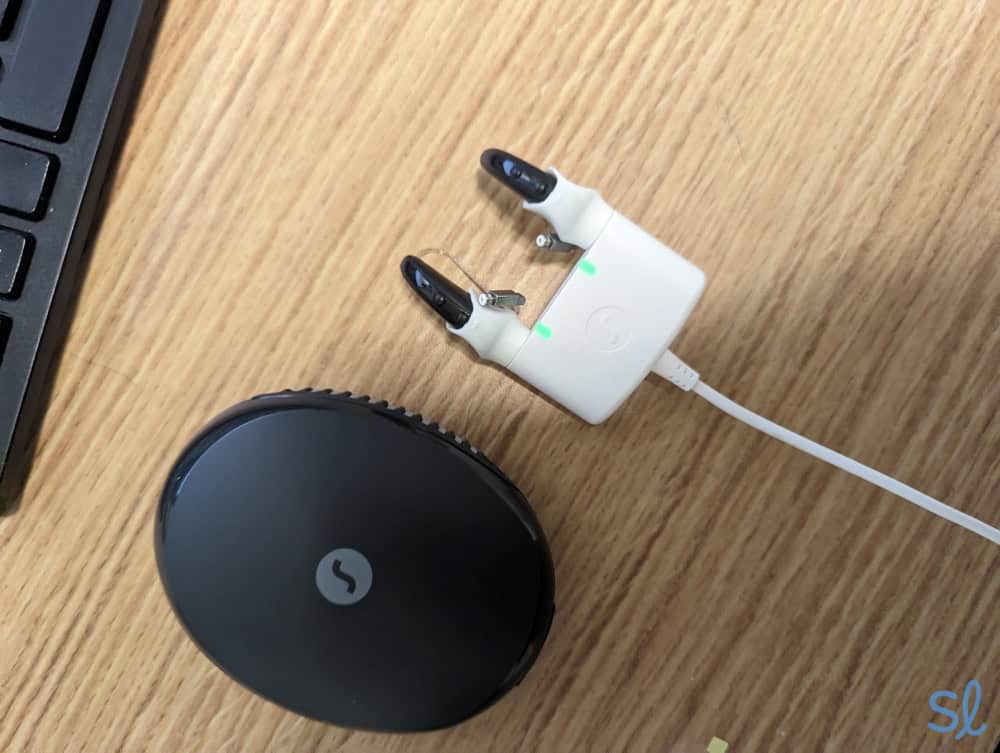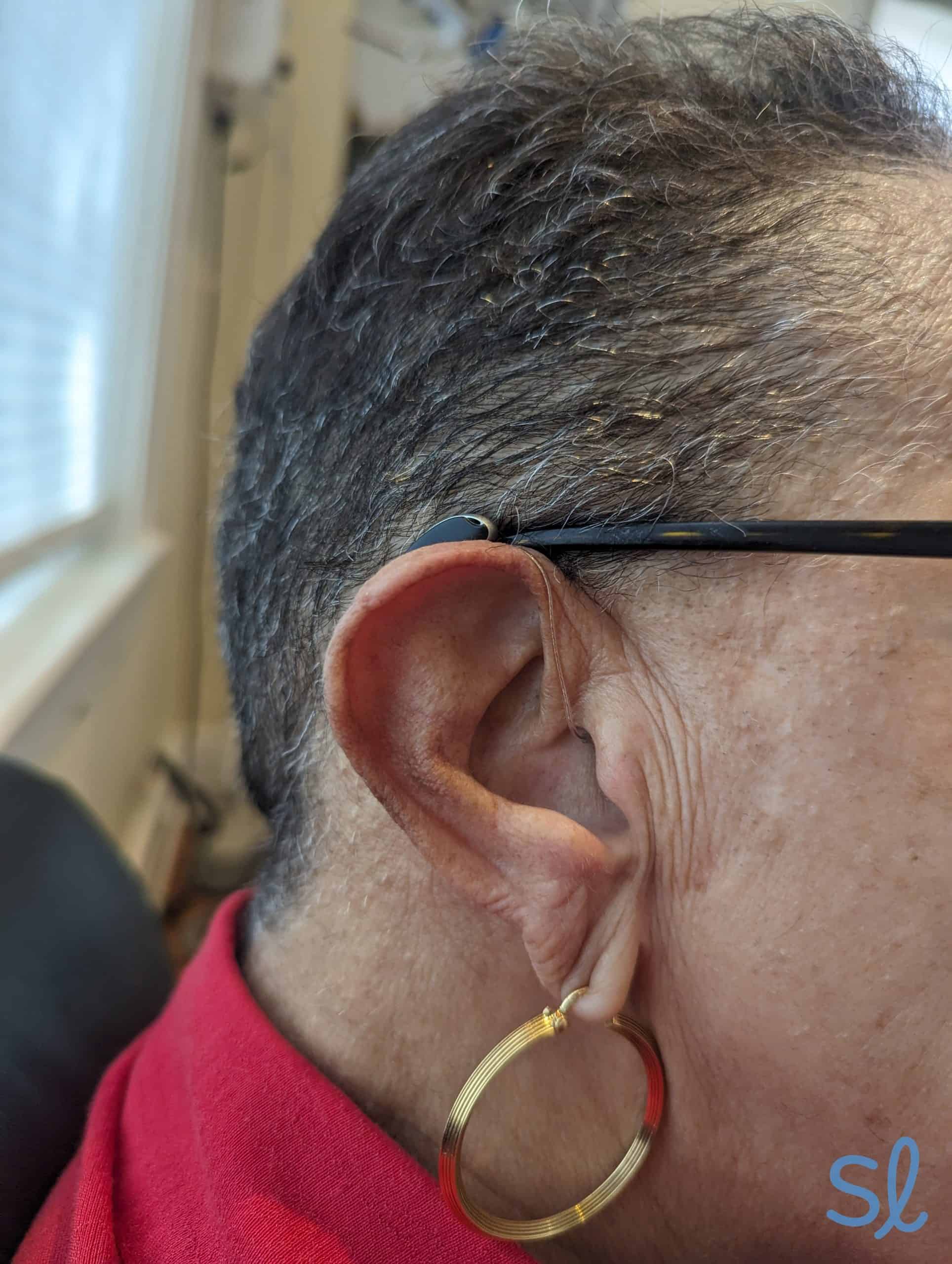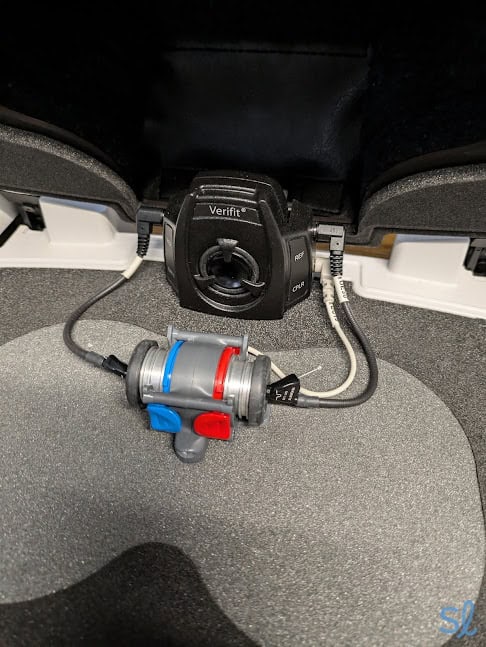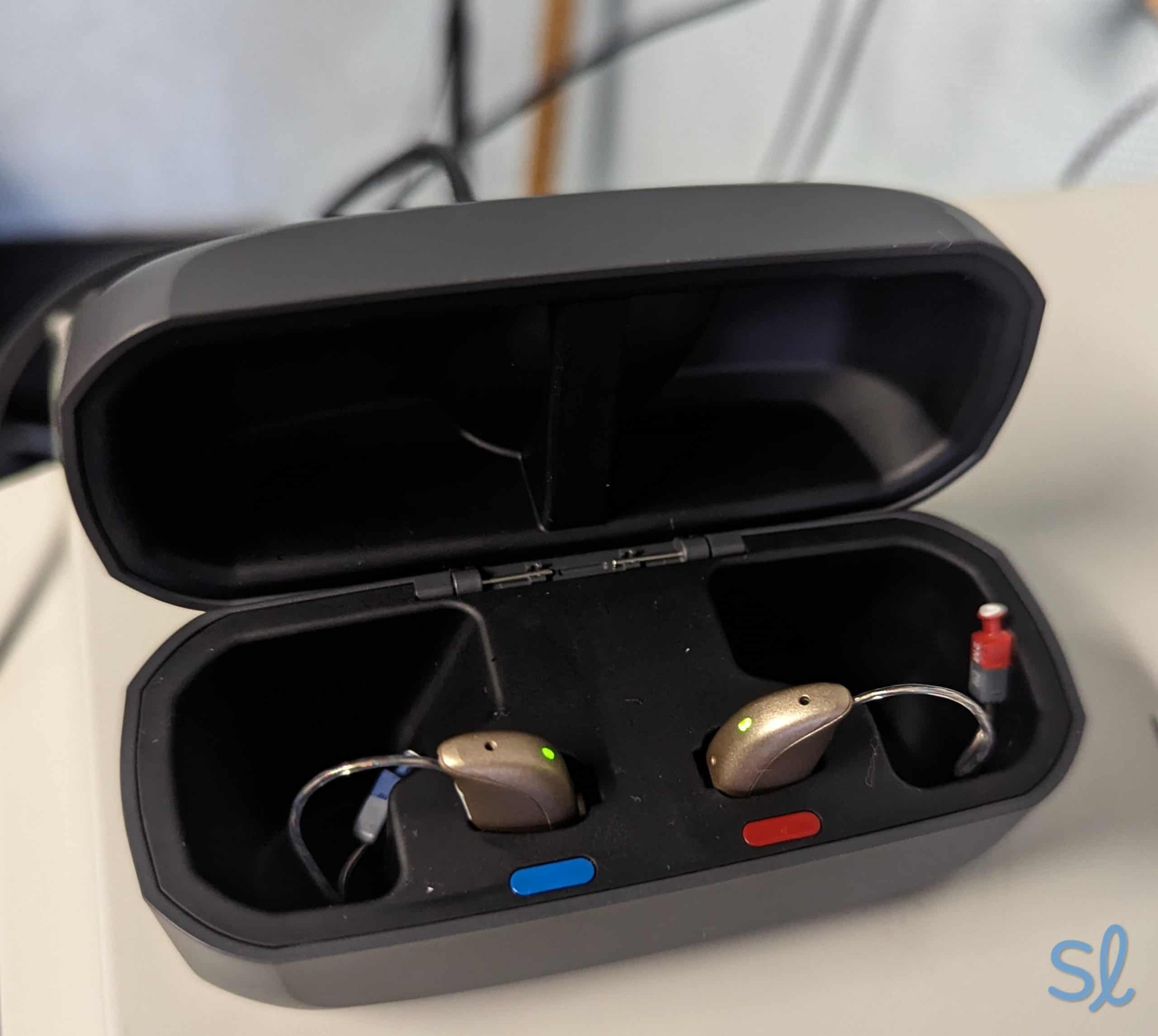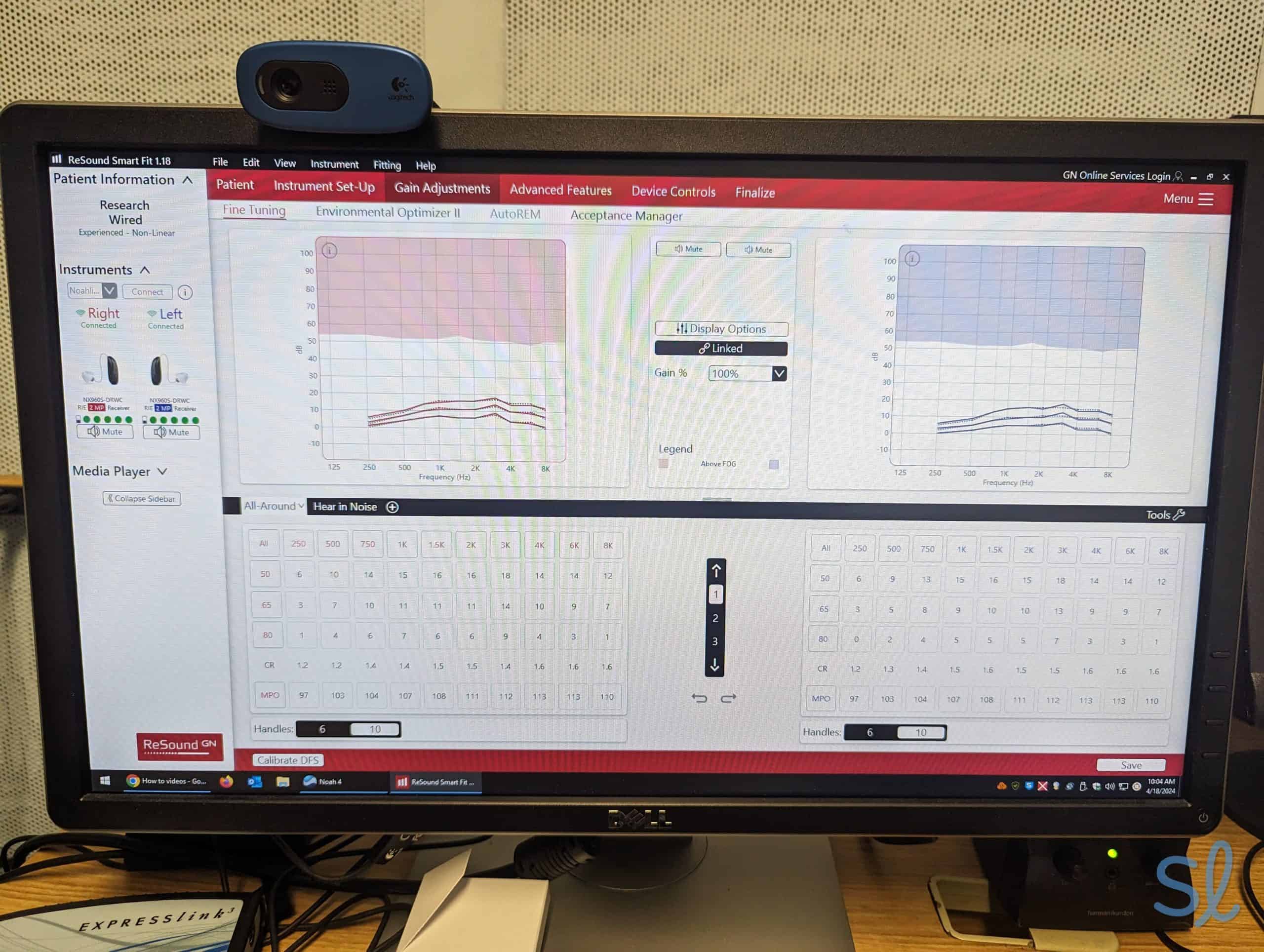Best Behind-the-Ear Hearing Aids, Tested and Evaluated by Audiologists
Jabra Enhance is our top pick for Bluetooth hearing aids, thanks to their compatibility with most devices, solid value, and excellent follow-up care.
SeniorLiving.org is supported by commissions from providers listed on our site. Read our Editorial Guidelines
- Prices start at $995 per pair
- Multiple behind-the-ear models
- Three years of follow-up care with premium packages
- Prices start at $297 per pair
- Behind-the-ear and in-ear models
- Lifetime support from hearing specialists
- Prices start at roughly $2,000 per pair
- Behind-the-ear and in-ear models
- Lifetime support from customer care team
- Options for all levels of hearing loss
- State-of-the-art devices and features
- Custom hearing aids
Our team of audiologists and tech experts tested the industry’s leading hearing aids to select our top picks for behind-the-ear models.
Our team of audiologists and tech experts tested the industry’s leading hearing aids to select our top picks for behind-the-ear models.
Learn MoreContents
Key Takeaways
- We picked Jabra Enhance as our top behind-the-ear (BTE) hearing aid for its excellent Bluetooth streaming, user-friendly mobile app, and three years of audiologist support that comes with Premium packages.
- The cost of BTE hearing aids varies substantially among providers but varies between OTC and prescription hearing aids. You can expect to pay between $300 and $2,000 per pair of OTC hearing aids or between $2,000 and $8,000 per pair of prescription hearing aids.
- Among adults ages 60 and older with hearing loss, approximately 84 percent pick BTE hearing aids as their preferred style.1
BTE, short for behind the ear, is one of the most common and popular types of hearing aids on the market. It is suitable for many different levels of hearing loss. You can find BTE hearing aids at nearly any price point, making them an accessible choice for most seniors. BTE models may not be as discreet as in-canal models, but they’re often easier to adjust manually and may provide better sound quality and more advanced features.
Our team of senior tech experts and Dr. Ruth Reisman, a licensed audiologist and hearing aid dispenser, have tested and reviewed the best hearing aids to create our list of top BTE picks. We chose the hearing aids below based on essential factors like comfort, size, performance, price, and additional useful features. After over 100 hours of research and testing, we selected Jabra Enhance as our top pick.

Our Methodology
How We Tested the Hearing Aids
We spent over 100 hours conducting hands-on testing and research for some of the most popular providers of BTE hearing aids. Here’s what our testing process looked like for OTC hearing aids that could be ordered online without a prescription.
- We tried each brand’s online hearing test, comparing our results to in-person evaluations from an audiologist.
- We selected our hearing aids and bought a pair online, evaluating the overall purchasing process. We considered the price and value of each hearing aid model, keeping in mind seasonal promotions, extra fees, and up-front costs.
- Once the devices arrived, we followed the instructions to set them up. If the brand had a mobile app, we downloaded it to our phones and set it up. We evaluated the ease of use and the total number of steps required to get our BTE hearing aids up and running.
- We contacted customer service several times to evaluate the quality of care by phone, mobile app (if applicable), and online chat features.
- Our team tested each hearing aid for a week, using them at home, in noisy environments, and in one-on-one conversations (in person and over the phone). We evaluated the hearing aid’s features, sound quality, and ease of use in each location.
For prescription hearing aids that can’t be ordered online, such as Signia and ReSound, we spoke with Dr. Reisman about her expertise with each brand. We used her experience prescribing and testing the hearing aids, along with feedback from her patients, to evaluate and rank them.
How We Chose the Best Hearing Aids
Choosing the right pair of hearing aids is an important decision, as you use them daily. Our tech team and resident audiologist, Dr. Ruth Reisman, narrowed the search by comparing popular BTE hearing aids side by side and evaluating them based on several criteria. Our team considered factors like:
- Comfort: Since BTE hearing aids are devices that rest behind the ears, with a tube placing the receiver in your ear, it’s important to consider the comfort of wearing these devices all day. We tested dozens of hearing aids to understand which providers and models offer the most comfortable fit.
- Size: BTE hearing aids tend to be larger and more noticeable than in-canal alternatives, but the size of the device can still be an important factor for many seniors. Larger devices can make the hearing aids less discreet, while smaller devices might be easier to misplace. We included the top providers that offer BTE hearing aids in multiple styles and sizes.
- Performance: Sound quality is one of the most critical features of any hearing aid. Fortunately, BTE hearing aids often have some of the best tech and microphones, though overall sound quality can vary substantially from one model to the next. Every provider on this list offers hearing aids with superior sound quality and performance.
- Price: More than 1 in 4 seniors don’t get hearing aids because of the cost. Hearing aids can be a major investment, and we understand everyone’s budget is different. Our team of experts evaluated a wide range of BTE hearing aids — from no-frill budget models to top-of-the-line devices.
- Additional features: Though some older adults with hearing loss might prefer simple hearing aids that just make it easier to have a conversation, others may prefer models with the latest and greatest features. Our team looked for providers offering various useful features, including Bluetooth streaming, rechargeable batteries, remote audiologist support, tinnitus management, and companion mobile apps.
Why Trust Us
Our team of tech experts tries the latest gadgets for older adults each year. We’ve logged hundreds of hours testing and reviewing hearing aids from dozens of providers.
We also worked extensively with our resident licensed audiologist, Dr. Ruth Reisman. She has personally tested and prescribed hearing aids from providers on this list. She also helped us choose the best BTE hearing aids, offered feedback on specific providers and models, and approved our top picks. Dr. Reisman has over 15 years of experience working with seniors with hearing loss.
Comparing the Best BTE Hearing Aids

Jabra Enhance
|

MDHearing
|
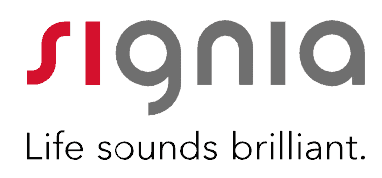
Signia
|

ReSound
|
|
|---|---|---|---|---|
| Rating | 4.8 | 4.7 | 4.6 | 4.4 |
| Starting price | $995 per pair | $297 per pair | $2,000 per pair | $2,000 per pair |
| BTE models | 3 | 3 | 5 | 4 |
| Battery type | Rechargeable | Rechargeable | Rechargeable or disposable | Rechargeable or disposable |
| Rechargeable battery life | Up to 24 hours | Up to 20,hours | Up to 61 hours | Up to 30 hours |
| Warranty | 3 years (with Premium) | 1 year | 2 to 3 years (varies by model) | 1 to 4 years (varies by model) |
-
1. Jabra Enhance - Best for audio streaming
 See Pricing Links to Jabra Enhance
See Pricing Links to Jabra EnhanceWhat we like most
- Prices start at $995 per pair
- Multiple behind-the-ear models
- Three years of follow-up care with premium packages
 Jabra EnhanceSee Pricing Links to Jabra EnhanceOverview:
Jabra EnhanceSee Pricing Links to Jabra EnhanceOverview:Jabra Enhance Select 300 hearing aids
All three of Jabra Enhance’s BTE hearing aid models offer direct Bluetooth streaming to compatible Apple and Android devices. We could stream music, videos, audiobooks, calls, and more from our phone right to the hearing aids, even with the Enhance Select 50R, the brand’s lowest-tier and most affordable model.
» Related Reading: Best cheap hearing aids for seniors
The Enhance Select 500 and Enhance Select 300 go further with hands-free calling for iPhone 11 and newer models. Not only could we hear the call in our hearing aids, but we could also speak to the caller through our hearing aids, too. Jabra Enhance also sells a Phone Clip+ accessory for hands-free calling on other phone and hearing aid models. If you’re a smartphone user, Jabra Enhance’s lineup of BTE hearing aids may be just what you’re looking for. Enjoy better speech clarity and noise reduction, along with streaming phone audio to your hearing aids. The Enhance Select 500 is the company’s smallest and lightest model, perfect for people who want a discreet BTE hearing aid.
Pros & Cons:Pros About Jabra Enhance
- Bluetooth streaming with all models
- Hands-free calling with some models
- Rechargeable batteries and high-tech accessories
- 100-day risk-free trial
- Three-year warranty with premium packages
- Mobile app for easy adjustments
Cons About Jabra Enhance
- Not for severe or profound hearing loss
- Small product lineup
Our Hands-on Experience:Our Experience With Jabra Enhance
Our tech team tested the provider’s mid-tier model, Enhance Select 300. The team found it a good option for seniors who want help in more complex listening environments (restaurants, parties, etc.) without going over budget.
» Also Check Out: Jabra Enhance Select 300 review
Jabra Enhance makes it easy for older adults who may be new to hearing aids by offering easy-to-follow instruction cards with its devices. Our tech team was able to speak with an audiologist to answer our questions and remotely oversee the initial fitting. We could also schedule unlimited audiologist appointments during the first three years of care. That is why we think the Premium package is worth the extra $200. If you ever run into any issues, those three years of audiologist support come in handy. We found the audiology team to be knowledgeable, helpful, and patient.
You can easily schedule an appointment with a Jabra Enhance audiologist through the mobile app.
Like MDHearing devices and many other BTE hearing aids, the Jabra Enhance Select 300 has buttons to make adjustments directly on the device. The right hearing aid can increase sound, and the left can decrease it. However, our team thinks there is a learning curve. You listen for the number of beeps the device makes as you press either button, allowing you to switch between programming like “restaurants” and “outdoors.”
» Our Full Review: Jabra Enhance hearing aids review 2025
Fortunately, Jabra Enhance offers the Jabra Enhance mobile app. Users can make further adjustments to connect the hearing aids via Bluetooth streaming. We found the Jabra Enhance app was practical and easy to use, similar to Signia. If you’re not comfortable using a smartphone app or don’t care about Bluetooth streaming, however, you may prefer MDHearing since the provider doesn’t offer an app or Bluetooth.
Making adjustments using the Jabra Enhance mobile app
Pricing
You can get a pair of Jabra Enhance hearing aids with a premium package for less than $2,000 per pair. There’s the Enhance Select 50R ($1,195 per pair), the Enhance Select 300 ($1,695 per pair), and the Enhance Select 500 ($1,995 per pair). If you want to save $200 on any model, you can select the Basic package. However, Basic packages don’t come with follow-up care or custom programming.
That puts Jabra Enhance, previously known as Lively, between premium in-office brands like Signia and budget online-only brands like MDHearing. Premium Jabra Enhance packages include a three-year loss and damage protection and warranty, three years of follow-up care, and a free mobile app. Jabra Enhance also offers financing if you’d like to spread out the cost of your purchase.
-
2. MDHearing - Most affordable
 See Pricing Links to MDHearing
See Pricing Links to MDHearingWhat we like most
- Prices start at $297 per pair
- Behind-the-ear and in-ear models
- Lifetime support from hearing specialists
 MDHearingSee Pricing Links to MDHearingOverview:
MDHearingSee Pricing Links to MDHearingOverview:Testing out MDHearing's VOLT devices
MDHearing offers two basic BTE and two in-the-ear (ITE) hearing aids to meet most seniors’ needs. The BTE models offer some advanced features like enhanced noise reduction and feedback cancellation. Plus, all models are available to purchase as singles or pairs, something you won’t find from other over-the-counter (OTC) providers like Jabra Enhance. It’s important to note that Dr. Reisman found that MDHearing’s BTE options can over-amplify sounds. To avoid this, we turned the volume on our devices down as low as possible and slowly increased it until it was comfortable.
» Top OTC Providers: Best over-the-counter hearing aids
If you’re unsure which model is best for you, MDHearing’s customer service team can help you make purchasing decisions via phone, email, or online chat. Once you become a customer, you can access free lifetime support from licensed hearing professionals at no extra cost. Plus, MDHearing offers some of the most affordable hearing aids on the market. If you don’t like your purchase, MDHearing has a 45-day risk-free trial.
Pros & Cons:Pros About MDHearing
- Affordable prices
- 45-day risk-free trial
- Rechargeable devices
- Buy in singles or pairs
- Lifetime support from audiologists and hearing specialists
Cons About MDHearing
- Only two BTE models to choose from
- No direct Bluetooth streaming
- BTE models can over-amplify sounds
- Not suitable for severe to profound hearing loss
Our Hands-on Experience:Our Experience With MDHearing
Our tech team tested out the VOLT model, the company’s most popular (according to MDHearing) BTE hearing aid. To get started, we took MDHearing’s free online hearing test, which can help you determine if one of their hearing aids can accommodate your level of hearing loss. Once we got the VOLT hearing aids, we were pleasantly surprised by the thorough instructions and tip cards to help us get our hearing aids up and running.
» A Deep Dive: MDHearing VOLT review
The VOLT took less than two hours to charge, and a single charge lasted for about 20 hours. This isn’t quite as good as Jabra Enhance’s Select 300, which can last up to 24 hours on a single charge, but it's not bad for a pair of hearing aids costing less than $400.
The MDHearing VOLT hearing aids are easy to charge, and a blue light indicates that they are charging.
One potential downside is that MDHearing doesn’t have a mobile app or any options for Bluetooth streaming. These features come standard with most Jabra Enhance, Signia, and ReSound devices. While Bluetooth streaming isn’t for everyone, having no mobile app means you’ll either need to manually adjust the devices or call customer support for assistance. It’s also important to consider that MDHearing only has two BTE models. So, if you are looking for more variety, you might be better off with prescription devices from a provider like Signia or ReSound.
» Our Full Review: MDHearing review in 2025
Pricing
MDHearing’s affordable prices are budget-friendly, and the hearing aids are always on sale. The NEO and AIR both cost $297 per pair, and the VOLT and NEO XS both cost $397 per pair. MDHearing also recently released the NEO XS PRO at $597 per pair. The company may not provide the same features and support as prescription hearing aids from Signia or ReSound, but they’re a great choice for older adults on a budget with mild to moderate hearing loss.
Did You Know? Of those aged 70 and above who could benefit from hearing aids, only 30 percent have ever used them.1
-
3. Signia - Most Innovative Designs
 See Pricing Links to Zip Hearing
See Pricing Links to Zip HearingWhat we like most
- Prices start at roughly $2,000 per pair
- Behind-the-ear and in-ear models
- Lifetime support from customer care team
 SigniaSee Pricing Links to Zip HearingOverview:
SigniaSee Pricing Links to Zip HearingOverview:Charging a pair of BTE Signia hearing aids
Signia offers innovative prescription hearing solutions for all levels of hearing loss, including some premium BTE options. Signia’s Motion X line of BTE hearing aids delivers 61 hours of power on a single charge, direct audio streaming from iOS devices, and enhanced speech recognition. Like ReSound, Signia also offers great features to help manage tinnitus.
» For Tinnitus Management: Best hearing aids for tinnitus in 2025
Signia hearing aids feature signature acoustic-motion sensor technology so you can hear better while moving. This feature is great for older adults who love to walk, run, bike, golf, and stay active. Unlike MDHearing, Signia lets you choose from multiple colors to match your skin tone or hair color. That is ideal if you want a BTE model that is still moderately discreet.
Pros & Cons:Pros About Signia
- Several BTE models to choose from
- Integrated tinnitus therapy
- Fast charging
- Professionally fitted and programmed
- Bluetooth streaming to iOS
- Remote app control and wireless accessories
- Solutions for all levels of hearing loss
Cons About Signia
- On the pricier side
- Requires an in-office visit
Our Hands-on Experience:Our Experience With Signia
If you’re in the market for an advanced BTE hearing aid with all the bells and whistles, you can’t go wrong with Signia. Their BTE hearing aids are comfortable, easy to use, and include advanced features like noise cancellation and automatic situation detection. The Signia smartphone app lets you make adjustments and access tinnitus management features from your phone.
Expert InsightsFrom Audiologist Dr. Ruth Reisman,Signia is one of my favorite hearing aid brands due to their innovative styles, the tools they offer to patients for hearing loss and tinnitus, and the ability to control the hearing aid microphones.Wearing Signia Styletto hearing aids
The higher price of Signia hearing aids, however, may deter older adults who are on a tight budget. You’ll also need to consider the cost of visiting a hearing care professional and potentially returning for multiple sessions to get your custom-fit devices. That said, if you want some of the best tech in hearing aids and you struggle with tinnitus or more severe hearing loss, Signia may be one of your top options.
» Our Full Review: Signia hearing aid reviews
Pricing
Signia doesn’t disclose its prices online. Instead, you’ll need to visit a hearing care professional to learn how much each model costs. Dr. Reisman estimates you can expect to pay between $1,000 and $3,750 per device, similar to the cost of a hearing aid from ReSound. But this price point is much more expensive than OTC hearing aids from Jabra Enhance or MDHearing.
So what comes with this higher price tag, and is it worth it? A hearing care professional can assess your hearing needs using in-depth hearing tests and evaluations. Then, they can suggest the Signia hearing aid that may work for you and share pricing information. Audiologists like Dr. Reisman also custom-fit these hearing aids and adjust settings so they work for your unique hearing loss. Plus, prescription hearing aids are available for severe to profound hearing loss, while OTC options are only suitable for mild to moderate losses.
Dr. Reisman uses specialized equipment to test Signia hearing aids and ensure they are the right fit for her patients
-
4. ReSound - Best rechargeable models
See Pricing Links to Zip HearingWhat we like most
- Options for all levels of hearing loss
- State-of-the-art devices and features
- Custom hearing aids
ReSoundSee Pricing Links to Zip HearingOverview:Testing out ReSound BTE hearing aids
ReSound brings nearly 80 years of experience in manufacturing hearing solutions to the table. Their current line of products includes some of the most advanced rechargeable BTE hearing aids on the market: the ReSound LiNX Quattro, Resound ONE, ReSound ENZO Q, and ReSound Key.
FYI: If you struggle with severe hearing loss that isn’t supported by most OTC providers, check out our guide to the best hearing aids for severe hearing loss.
The LiNX Quattro, ReSound’s premium collection, delivers rich sound, Bluetooth streaming, and impressive battery life. The LiNX Quattro offers up to 30 hours of use on a single charge, six hours longer than Jabra Enhance’s battery life. And charging on the go couldn’t be easier! The portable charging case holds three full charges, and charging for one hour gets you 16 hours of battery life. It’s a great solution for older adults who spend time off the grid or have trouble remembering to charge their devices.
Pros & Cons:Pros About ReSound
- Multiple BTE options with long battery lives
- Clear, natural sound quality
- Thin tube or personalized ear mold
- Direct streaming to iOS and Android devices
- Solutions for severe and profound hearing loss
- Remote care option
Cons About ReSound
- On the pricier side
- In-office visit required
Our Hands-on Experience:Our Experience With ReSound
ReSound is known for its innovation, quality, and value. They offer rechargeable BTE hearing solutions for all levels of hearing loss that deliver a full day’s charge and then some. You also get the added benefit of ReSound’s smartphone apps, which let you make remote adjustments and manage your tinnitus. ReSound’s tinnitus relief app is Dr. Reisman’s go-to app for her patients with tinnitus. When we tried out Jabra Enhance hearing aids, the company’s audiology team recommended this ReSound app. Just be prepared to pay more than you would for OTC brands like Jabra Enhance and MDHearing.
» Our Full Review: ReSound hearing aid reviews from an audiologist
Expert InsightsFrom Audiologist Dr. Ruth Reisman,ReSound’s top-tier hearing aids enhance natural sound quality, offer better hearing in noise, and enhanced connectivity options with Auracast technology.Pricing
Dr. Reisman estimates that ReSound hearing aids cost between $1,000 and $3,750 per hearing aid, similar to Signia. ReSound’s products come at premium prices, but the customization, technology, and support you receive more than justify the cost. Exact prices vary by location and provider, so you must visit a hearing professional for more details.
Like Signia, ReSound is a great fit for people with severe to profound hearing loss, who want more high-tech features, or want more hands-on care. Dr. Reisman, along with other audiologists, can adjust the hearing aids to best suit their patients' needs and levels of hearing loss.
Dr. Reisman can make adjustments to ReSound hearing aids to best suit her patient's needs
The Runner-Up
There were a few runners-up for affordable BTE hearing aids that didn’t make the cut, but they may be suitable for some users. You can learn more below.
- Lexie: Lexie makes the selection process easy by providing one simple BTE and two receiver-in-canal (RIC) solutions. Check out our review of Lexie hearing aids for more details.
- Otofonix: Whether you want a battery-powered or rechargeable device, traditional or app-controlled, Otofonix has an option. Otofonix is one of the industry’s most affordable OTC providers, and the company frequently runs promotions to help you save even more. Learn more in our Otofonix review.
What Are BTE Hearing Aids?
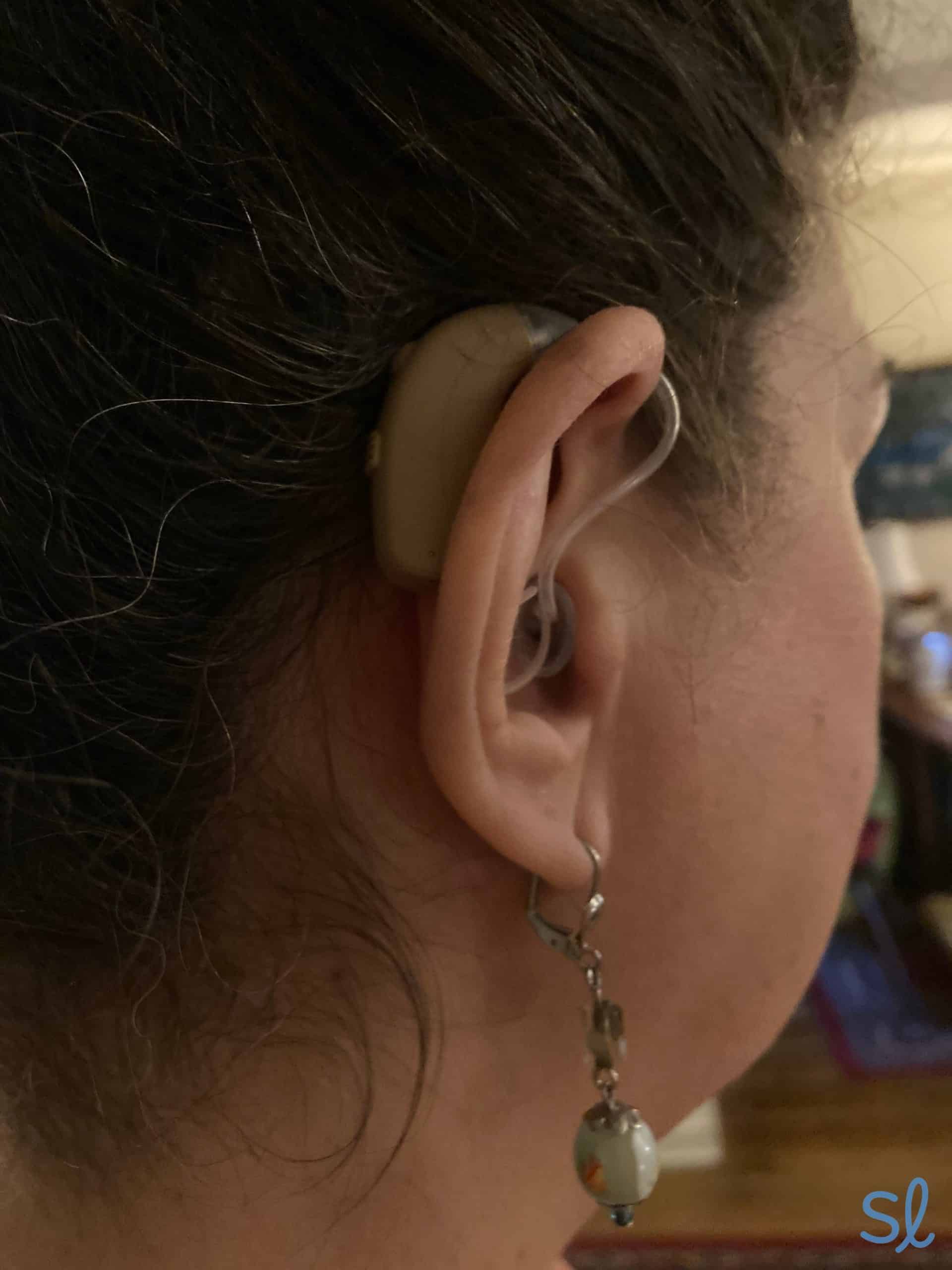
BTE hearing aids, like MDHearing's VOLT, may get in the way of certain types of exercise.
As you might’ve guessed, behind-the-ear (BTE) hearing aids sit behind your ears. More specifically, the electrical components housed inside a case sit on your outer ear. It includes the speaker, microphone, amplifier, battery, and other features like a telecoil. A small tube (also called an ear hook) connects the hearing aid to a dome or earmold that sits in your ear canal. The tube delivers sound into your ear.
» For Extra Help: How to put in hearing aids
BTE hearing aids provide the best amplification, so they can work great for people of all ages with mild, moderate, severe, or profound hearing loss (though this varies by provider and model). They’re also larger than other styles of hearing aids, so there’s more room for electrical components. That’s why many BTE hearing aids offer advanced features like Bluetooth streaming. Most BTE hearing aids feature control buttons directly on the case for easy volume or programming adjustments. We’d recommend BTE hearing aids for:
- Seniors with severe to profound hearing loss
- Those with dexterity problems who would benefit from a larger device
- Older adults with caregivers, as they’re easier for caregivers to assist with
- Individuals who produce a lot of earwax
Pros About BTE Hearing Aids
- Available with personalized ear molds
- Provide the most amplification
- Easy to put on, take off, and clean
- On-device controls for simple volume adjustment
- Not as susceptible to earwax buildup as other styles
- More comfortable, as they don’t sit deep in the ear canal
- Tend to have longer battery life than other styles
Cons About BTE Hearing Aids
- May be awkward to use while on the phone; selecting a model with Bluetooth streaming can alleviate this concern
- More sensitive to wind than other styles
- Share ear space with glasses, sunglasses, and masks, which may be bothersome to some seniors
- Not as discreet as other styles
Important Considerations When Choosing a BTE Hearing Aid
Here are some tips for finding the right hearing aid.
- Price: If you live on a fixed income or don’t have the funds to invest thousands of dollars in hearing aids, set a budget and see which models work best for your wallet. OTC models tend to be less expensive but have less advanced tech and aren’t suitable for severe or profound hearing loss.
- Comfort: BTE models may be larger, more visible, and perhaps even more cumbersome than ITE or CIC hearing aids, but they’re not all created equal. Some BTE models are smaller and more discreet than others. Ensure the device can fit comfortably behind your ear (that’s where risk-free trial periods come in handy).
- Battery life: There are plenty of disposable-battery hearing aids on the market, but most providers are shifting to rechargeable models. Rechargeable hearing aids can save you a lot of money in the long term and help you avoid the hassle of replacing tiny batteries every few days or weeks. That said, you’ll want to consider how long a specific hearing aid model can last on a single charge so you don’t have to stay close to a charger at all times.
- Bluetooth connectivity: Bluetooth makes it easier to enjoy your favorite media (movies, YouTube videos, music, podcasts, etc.) with your hearing aids. It enables you to stream audio directly from your phone, computer, TV, or smart-home device to your Bluetooth-ready hearing aids. That results in a clearer listening experience. Bluetooth connectivity can also allow you to make remote adjustments to your hearing aid settings from your smartphone.
- Hearing loss level: This is extremely important, especially if your hearing loss is severe or profound. OTC hearing aids generally work very well for mild to moderate hearing loss. For severe or profound hearing loss, you’ll need a prescription from a licensed hearing professional (and a higher-cost hearing aid).
How Much Do BTE Hearing Aids Cost?
The cost of BTE hearing aids can vary substantially by type and brand. Based on our research and discussions with Dr. Reisman, you can expect to pay between $300 and $2,000 for a pair of OTC BTE hearing aids and between $2,000 and $8,000 for a pair of prescription hearing aids. In short, you can find BTE hearing aids for just about any budget, but the look, sound quality, and features will vary with the price.
Money Tip: Need help setting a budget for your hearing aids? Here are the best budgeting apps for seniors.
BTE vs. ITE Hearing Aids
There are two main types of hearing aids: behind-the-ear (BTE) and in-the-ear (ITE). Understanding the difference between the two can help you decide what may work best for your situation.
What Are ITE Hearing Aids?
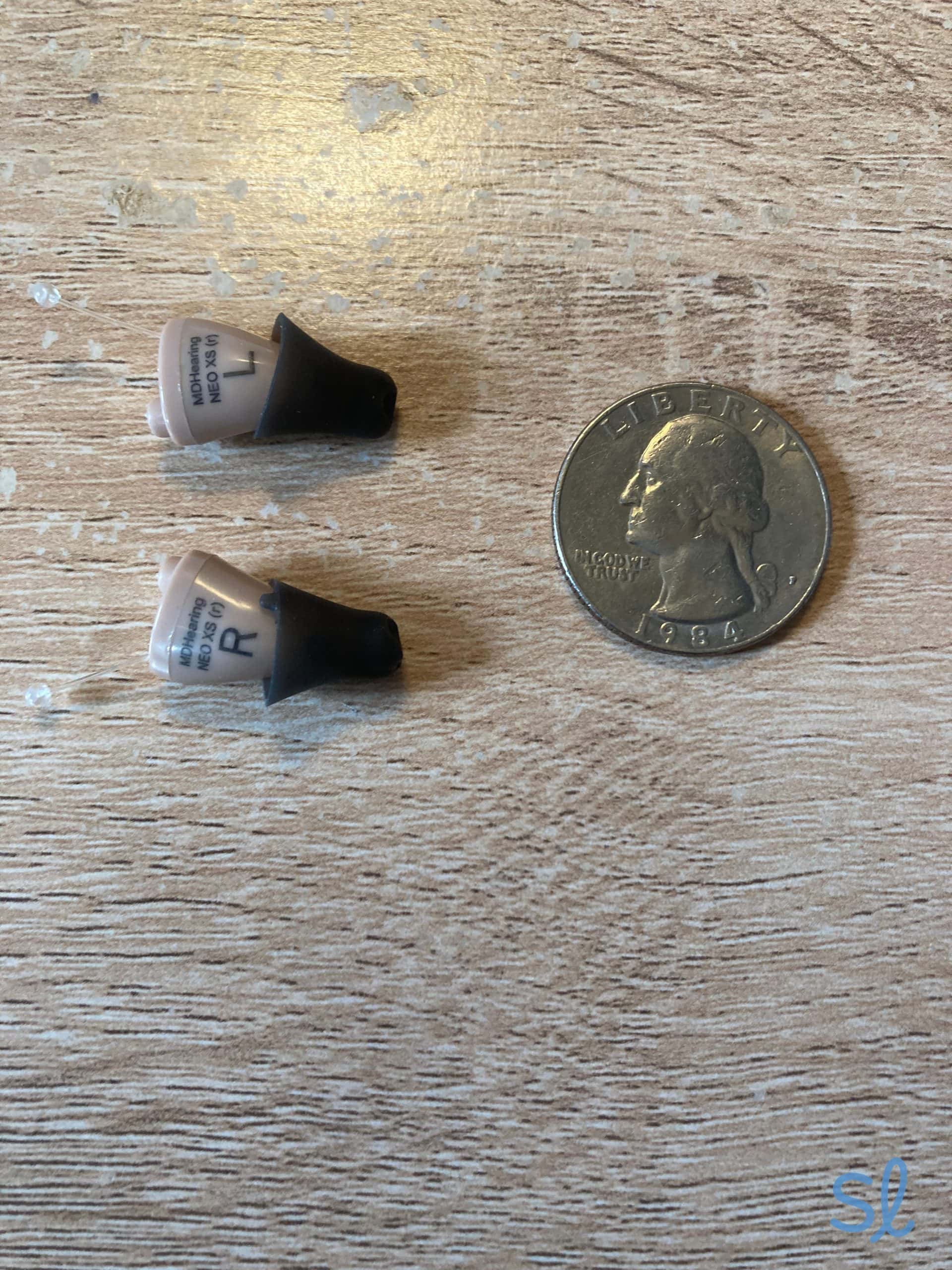
MDHearing, one of our favorite OTC brands, is a runner-up on our list of the best hearing aids for tinnitus.
ITE hearing aids sit fully in your ear without taking up any space on or behind your ear. For that reason, an ITE hearing aid is more comfortable than a BTE if you wear glasses or frequently wear a face mask. You can use a phone more naturally and wear over-ear headphones, too. Compared to BTE models, ITE hearing aids are more discreet. Most are custom-fit to your ear canal for a snug, comfortable fit. They’re even available in multiple skin tones to blend in with your ear.
Pro Tip: Want to find hearing aids that won’t draw attention? Check out our guide to the best invisible hearing aids.
Since they must sit in your ear, ITE hearing aids have limited space. They don’t have room for all of the features you may find with BTE hearing aids, such as Bluetooth connectivity or large, long-la
Comparing Hearing Aid Styles
| BTE | ITE | |
|---|---|---|
| Type of hearing loss | For mild to profound hearing loss | For mild to severe hearing loss |
| Size | Bigger; can be clunky | Small; often custom fit |
| Visibility | Slightly visible | Nearly invisible |
| Durability | Tend to last longer | More susceptible to earwax damage |
| Battery life | Can accommodate larger, longer-lasting batteries | Less reliable; batteries need to be charged or replaced more frequently |
| Amplification | Better amplification | Less powerful |
| Features | Space for more electrical components and features, such as Bluetooth | Limited features |
Want to learn more about the different types of hearing aids? Check out our video below with audiologist Dr. Brad Ingrao.

Additional Hearing Aid Resources
Want to compare all your options? We’ve tested and reviewed hearing aids for several other categories that could help you find the right fit.
Frequently Asked Questions About BTE Hearing Aids
-
Can I wear BTE hearing aids with glasses?
Yes, you can wear BTE hearing aids and glasses simultaneously. In most cases, it’s best to put on your glasses or sunglasses first and then your BTE hearing aids.
-
How can I hide my BTE hearing aids?
BTE hearing aids are not very discreet, so there’s no perfect way to hide them. You may consider wearing hats, scarves, or other accessories that can partially hide the area behind your ears. You can also choose hearing aid colors that match your skin tone to make them less visible.
-
Are BTE hearing aids better than ITE?
BTE and ITE hearing aids both have advantages and disadvantages. In general, BTE hearing aids are suitable for a more substantial range of hearing loss than ITE hearing aids.
-
How do you keep BTE hearing aids in place?
When fitted properly, BTE hearing aids stay in place all on their own. Just take care as you put on and remove face masks, glasses, or sunglasses so as not to pull or bump the hearing aids off of your ears.
-
What is a mini BTE hearing aid?
Mini BTE hearing aids are the smallest style of BTE hearing aids. They are smaller, more discreet, and often lighter than standard BTE hearing aids.
National Library of Medicine. (2023). Change in the Characteristics of Patients Qualified for Hearing Aids over the Last 25 Years in Poland.



